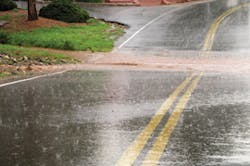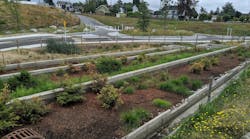Water harvesting on a large scale sounds simple in principle but, in practice, is beset with difficulties. A two-part article in our March/April and May 2013 issues looked at many of the issues surrounding rainwater harvesting, such as storing water for long periods and navigating the thorny question of water rights. As I noted then, stormwater managers have traditionally viewed stormwater not as a resource, but as a nuisance to be eliminated–sometimes by routing it to a river or ocean, and more recently by infiltrating it using low-impact development or green infrastructure measures.
There are some compelling reasons for this. In a Stormwater article on stormwater management in arid and drought-prone regions, the deputy commissioner of Atlanta’s Bureau of Watershed Protection noted that the city was at that time not initiating any large-scale municipal stormwater collection or redistribution policies: “There is literally no accumulation or ponding. From a surface water management perspective, we have no stormwater delivery options.”
And an article on the feasibility of rainwater harvesting in southern California noted that, despite the concept working well in some areas with predictable rainfall spread more or less evenly throughout the year—Sydney, Australia, for example—California’s arid climate and uneven rainfall distribution make harvesting economically unfeasible; the amount of water needed to be stored, and the cost of storing it, is just prohibitive.
Yet despite these objections, the growing populations in water-starved areas—not to mention the drought—are prompting communities to take a closer look. Some California cities are now pondering how to make treated wastewater safe for potable use; others are planning desalination facilities or reactivating decommissioned ones. Making use of stormwater starts to sound like a better option.
And we are making some progress toward capturing and using rainfall. Organizations like the American Rainwater Catchment Systems Association have been working to promote rainwater harvesting. You can read about the association’s efforts, and find some useful calculators for sizing collection systems and storage tanks, at www.arcsa.org.
Now there are even more tools to help us put stormwater to practical use. An article in our May issue will take a look at how it’s actually working in some of the driest areas of the US. The Desert Landscape Conservation Cooperative, developed from a partnership between the Bureau of Reclamation and the US Fish and Wildlife Service, spans parts of California, Nevada, Arizona, New Mexico, and Texas–the most arid and lately drought-stricken parts of the country. Although most of the research on water harvesting has been carried out in much wetter climates, the LCC is helping cities in these drier regions find ways to make water harvesting work in the desert, too.
The article presents successful examples, such as Tucson, AZ, the first city in the nation to pass a commercial water harvesting ordinance. In effect since 2010, the ordinance requires developers of commercial properties to meet at least half their landscape irrigation needs through harvesting. The city also promotes household-scale water harvesting, with financial incentives—rebates—for homeowners who learn how to do it successfully.
The Desert LCC offers tools—the Water Harvesting Assessment Toolbox, or WHAT—to help communities figure out whether a similar program is workable for them, including helping them to evaluate land-use sectors with the most water harvesting potential and to prioritize different approaches.
Stormwater professionals and others have talked for years about integrating water management rather than compartmentalizing drinking water, wastewater, and stormwater to the extent most cities currently do. (And EPA, in fact, has been encouraging cities to develop integrated stormwater and wastewater management plans.) Spurred by the ongoing drought, and with new tools available to make it easier, it looks like we’re finally taking another step in that direction.
About the Author
Janice Kaspersen
Janice Kaspersen is the former editor of Erosion Control and Stormwater magazines.


